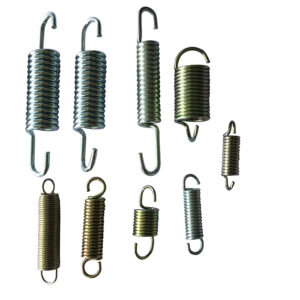Tension springs
Cylindrical spiral custom tension springs are generally of the turn-to-turn contact type. Since there is no need to open the gear, the rolling process is simpler than that of the compression spring.
For general tension springs, there is no technical requirement for the initial tension, and it can be rolled on the mandrel by the ordinary guide rod method. When rolling, there is no need to open the gear (sometimes according to the diameter of the material), and the material is driven by the coiled screw. However, for tension springs that require initial stress, some necessary process measures need to be taken during rolling.
How are tension springs produced
When rolling a custom tension spring with initial tension, greater tension must be generated between the coils. The first is an ordinary core wire winding; the other is a winding method in which the steel wire is twisted and then wound on the mandrel. The steel wire is wound in the direction to form a tension between the coils; the rolling method is used to roll, and a greater tightness can be obtained. During the rolling process, the steel wire is introduced through the guide plate and pressed on the mandrel between the coil spring and the stopper by means of a roller. The guide plate is introduced in an angle with the direction perpendicular to the mandrel.
Tension springs Manufacturing
The larger the winding ratio and pitch of the spring, the smaller the plastic deformation, the more unstable the internal stress, and the more difficult the precision control of the spring diameter and pitch. Therefore, when winding a spring with a larger winding ratio and pitch, special attention should be paid to the operation of each process. For example, the speed should be slow when commutation, light when bearing the rolled spring blank, and the movement should be as little as possible before stress removal and annealing. For a spring blank with a larger coiling rate, it is better to roll it and then fix it, and then perform stress removal annealing with the mandrel at the same time and then remove it from the mandrel.
Custom Tesion Springs

The feed angle when coiling the spring will affect the natural torque of the spring during the rolling process, and the magnitude of the torque will also affect the size and characteristics of the spring. For extension springs, by adjusting the natural torque of the spring, the so-called initial tension, to reduce the working stress, thereby forming the spring’s opening resistance under load. In production practice, the tension spring with initial tension is rolled by adjusting the feeding angle and feeding tension. In order to obtain a tension spring with a large initial tension, a special rolling method in which the torsion force is adjusted multiple times can be used during rolling. The wrapping method is one of the methods. The winding method is roughly as follows: first wind the metal wire on the hollow mandrel, wind it into a dense spiral spring opposite to the desired spiral direction, and leave a part of the wire elbow. Then insert the spring blank with the hollow mandrel into the cylindrical mandrel, insert the end with the elbow into the mandrel hole, form part of the tension through the clamping device, and then press it in the opposite direction. It becomes a tension spring with a large initial tension.
The closed coil spring made of steel wire that does not need to be quenched has part of the initial tension. If the initial tension is not required, there should be a gap between each coil.
Custom Tension springs Service
We are professional manufacturer specializing in R & D, manufacturing and sales of all kinds of springs,such as Compression springs, torsion springs, extension springs, flat spiral springs, and kinds of custom wire form products.






